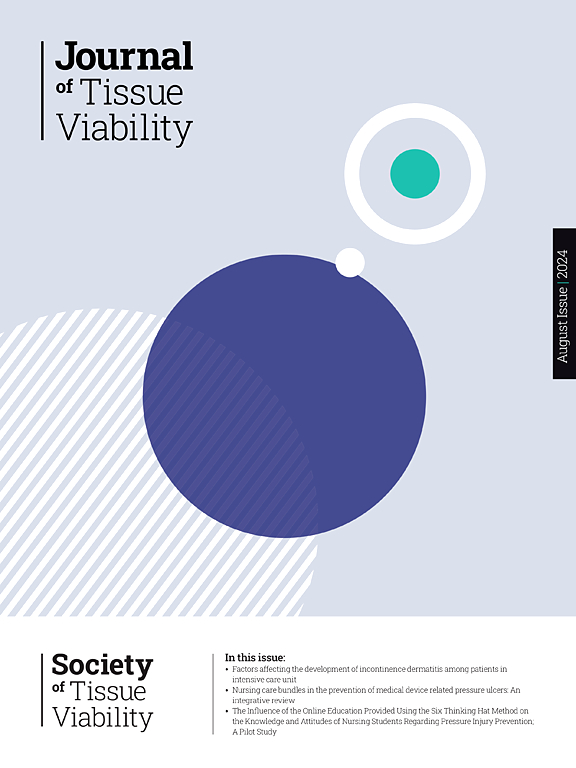使用移动应用程序监测急性期出院后的引流部位和手术伤口--新加坡的一项可行性研究。
IF 2.4
3区 医学
Q2 DERMATOLOGY
引用次数: 0
摘要
目的:本研究旨在证明带伤口或引流管出院的手术患者对远程医疗监控的依从性、可行性和可接受性:这是一项横断面可行性研究。研究采用便利抽样法,招募了有伤口和/或手术引流管的乳腺、整形和肝胆外科术后患者。对照组接受常规护理,包括每日电话随访。干预组使用移动伤口应用软件拍摄伤口和引流管图像,报告引流量和症状。通过测量患者实际输入量与预期输入量的百分比来评估依从性,通过比较异常检测和意外医院就诊来评估可行性,通过干预组护士和患者的主观反馈来评估可接受性:共招募了 59 名患者,其中对照组 30 人,干预组 29 人。9 名专科护士参与了患者出院后的护理工作。肝胆科、乳腺科和整形科患者的平均依从率分别为 89.9%、89.5% 和 75.9%。干预组有 4 名患者(13.8%)和对照组有 6 名患者(20.1%)被标记为潜在异常。至于意外到医院就诊,干预组有 2 例(6.9%),对照组有 1 例(3.4%)。25 名患者和 9 名专科护士对反馈调查做出了回复。22 名患者(88%)没有遇到任何应用问题。18 名患者(72%)更愿意通过应用程序自我报告症状,而不是打电话给护士,并表示知道自己受到远程监控后感到很安全。大多数护士认为该应用程序既方便又省时(7 人,78%),通过图片进行监测比电话交谈更准确(8 人,89%):结果表明,带伤口或引流管出院的手术患者使用移动应用程序是可行的,并且是一种可行的监测工具。本文章由计算机程序翻译,如有差异,请以英文原文为准。
Use of a mobile application to monitor drain sites and surgical wounds after discharge from acute care - A feasibility study in Singapore
Purpose
This study aimed to demonstrate the compliance, feasibility, and acceptability of telehealth monitoring among surgical patients discharged with wounds or drains.
Methodology
This is a cross-sectional feasibility study. Post-surgical breast, plastic, and hepatobiliary patients with wounds and/or surgical drains were recruited using convenience sampling. The control group received conventional care which consisted of daily telephone follow-up. The intervention group used a mobile wound application to take wound and drain images, report drainage amount and symptoms. Compliance was assessed by measuring the percentage of actual to expected patient entries, feasibility was assessed by comparing detection of abnormalities and unexpected hospital visits, and acceptability was assessed by subjective feedback from nurses and patients from the intervention group.
Results
59 patients were recruited, with 30 patients in the control group and 29 patients in the intervention group. 9 specialty nurses were involved in the patients’ post-discharge care. The mean compliance rate for the hepatobiliary, breast and plastic patients were 89.9 %, 89.5 % and 75.9 % respectively. 4 patients from the intervention group (13.8 %) and 6 patients from the control group (20.1 %) were flagged as having potential abnormalities. As for unexpected hospital visits, there were 2 (6.9 %) in the intervention group and 1 (3.4 %) in the control group. 25 patients and 9 specialty nurses responded to the feedback survey. 22 patients (88 %) did not face any application issues. 18 patients (72 %) preferred to self-report symptoms via the application rather than to call the nurses and reported feeling safe knowing that they are remotely monitored. Most nurses found the app convenient and timesaving (n = 7, 78 %), with monitoring through pictures as more accurate than phone conversation (n = 8, 89 %).
Conclusion
The results suggest that use of a mobile application by surgical patients discharged with wounds or drains is feasible and serves as a viable monitoring tool.
求助全文
通过发布文献求助,成功后即可免费获取论文全文。
去求助
来源期刊

Journal of tissue viability
DERMATOLOGY-NURSING
CiteScore
3.80
自引率
16.00%
发文量
110
审稿时长
>12 weeks
期刊介绍:
The Journal of Tissue Viability is the official publication of the Tissue Viability Society and is a quarterly journal concerned with all aspects of the occurrence and treatment of wounds, ulcers and pressure sores including patient care, pain, nutrition, wound healing, research, prevention, mobility, social problems and management.
The Journal particularly encourages papers covering skin and skin wounds but will consider articles that discuss injury in any tissue. Articles that stress the multi-professional nature of tissue viability are especially welcome. We seek to encourage new authors as well as well-established contributors to the field - one aim of the journal is to enable all participants in tissue viability to share information with colleagues.
 求助内容:
求助内容: 应助结果提醒方式:
应助结果提醒方式:


